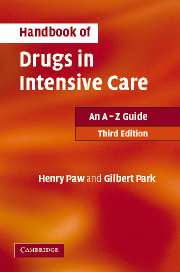Book contents
- Frontmatter
- Contents
- Introduction
- How to use this book
- Abbreviations
- Acknowledgements
- DRUGS: An A-Z Guide
- SHORT NOTES
- APPENDICES
- Appendix A Creatinine clearance
- Appendix B Weight conversion (stones/lb to kg)
- Appendix C BMI calculator
- Appendix D Lean body weight charts
- Appendix E Infusion rate/dose calculation
- Appendix F Drug compatibility chart
- Appendix G Omeprazole administration record
- Appendix H Drotrecogin prescribing criteria
- Appendix I Drotrecogin administration
- Appendix J Drotrecogin administration record
- DRUG INDEX
- Plate section
Appendix F - Drug compatibility chart
Published online by Cambridge University Press: 06 December 2010
- Frontmatter
- Contents
- Introduction
- How to use this book
- Abbreviations
- Acknowledgements
- DRUGS: An A-Z Guide
- SHORT NOTES
- APPENDICES
- Appendix A Creatinine clearance
- Appendix B Weight conversion (stones/lb to kg)
- Appendix C BMI calculator
- Appendix D Lean body weight charts
- Appendix E Infusion rate/dose calculation
- Appendix F Drug compatibility chart
- Appendix G Omeprazole administration record
- Appendix H Drotrecogin prescribing criteria
- Appendix I Drotrecogin administration
- Appendix J Drotrecogin administration record
- DRUG INDEX
- Plate section
Summary
Ideally, all drugs given intravenously should be given via a dedicated line or lumen, and not mixed at any stage. However, if this is not possible, then compatibility data must be obtained before co-administering drugs. In general, drugs should not be added to parenteral nutrition. Blood products, sodium bicarbonate and mannitol should not be used for intravenous drug administration.
As a general guide, line compatibility of different drugs often depends on the pH of the drugs concerned. This will vary depending on how the drug is reconstituted or diluted. Drugs with widely differing pH will almost certainly be incompatible. However, the converse is not necessarily true, and lines should always be checked regularly for any gross signs of incompatibility (e.g. precipitate formation).
This chart indicates whether two drugs can be run in through the same IV access. It assumes normal concentrations and infusion rates for each drug, and data may vary depending on the diluent used. It should be used as a guide only, and not taken as definitive.
- Type
- Chapter
- Information
- Handbook of Drugs in Intensive CareAn A - Z Guide, pp. 249 - 253Publisher: Cambridge University PressPrint publication year: 2007



